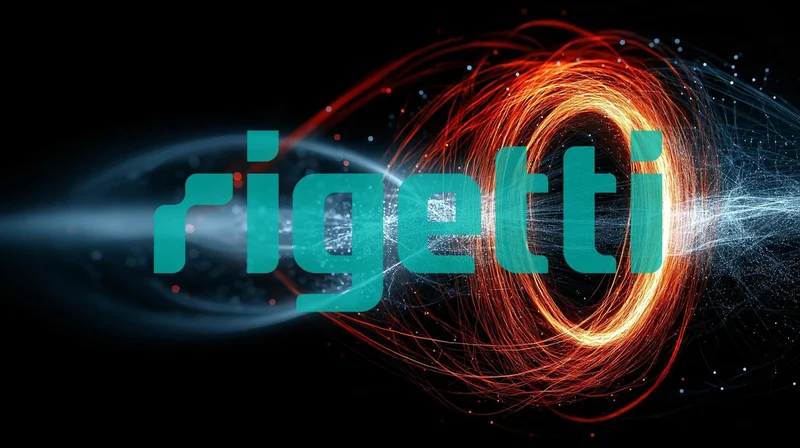The stock chart for Rigetti Computing (NASDAQ:RGTI) in September and early October of 2025 looks less like a valuation curve and more like a rocket launch trajectory. A surge of roughly 135% in a single month, culminating in a share price north of $35 and a market capitalization cresting $11 billion, has captured the market's attention. The trading volume on October 2nd alone was astronomical—around 145 million shares, a figure that dwarfs the company’s entire float.
The narrative fueling this ascent is, on the surface, compelling. Rigetti has announced a string of positive developments: two purchase orders for its Novera quantum systems totaling $5.7 million, a $5.8 million contract from the U.S. Air Force, a strategic partnership with manufacturing giant Quanta Computer, and an MOU with India’s advanced computing center. Technologically, the company rolled out its 36-qubit Cepheus-1-36Q system, boasting a 99.5% fidelity rate.
These are tangible, positive steps. They signal a transition from a pure R&D entity to a company beginning to secure commercial and government validation. The market has interpreted this news not just as progress, but as a definitive sign that the quantum future has arrived, and that Rigetti is its chosen vessel. This sentiment is reflected in headlines like Rigetti (RGTI) Quantum Computing Stock Soars on Major Orders and Partnerships.
The problem is, when you move from the press releases to the financial statements, the numbers tell a profoundly different story. The disconnect between the market’s valuation and the company’s current operational reality is not just a gap; it's a chasm. And that is the central question we must analyze: Is RGTI’s stock price a forward-looking indicator of inevitable dominance, or is it a function of a market narrative that has become completely untethered from financial gravity?
The Glaring Discrepancy in the Data
Let’s establish the baseline. Rigetti’s revenue for the second quarter of 2025 was $1.8 million. For the prior twelve months, total revenue was about $8 million—to be more exact, $7.9 million. The company posted a net loss of $39.7 million in Q2 alone. Against this, the market has assigned it a valuation that, at its peak, exceeded $11.5 billion. This translates to a price-to-sales ratio of approximately 981x.
To put that number in perspective, even the most aggressive, high-growth tech stocks during the dot-com bubble rarely sustained such multiples. This isn't a valuation based on fundamentals; it's a valuation based on a story. The story is that Rigetti’s modular chiplet architecture is the key to scalable quantum computing, a technology that could revolutionize entire industries. The recent contracts, while small, are treated as proof of concept for a multi-trillion-dollar future market.
This is where I find the current analysis so puzzling. The market is pricing Rigetti as if it has already won the quantum race. Investing in the company today is like buying a deed to a gold mine based on a promising geological map and a few gold flakes found in a nearby stream. The recent purchase orders ($5.7 million) and the Air Force contract ($5.8 million) are those gold flakes. They are real, but they don’t prove the existence of a massive, commercially extractable vein of ore. Yet, the price of the deed is being bid up as if the mine is already producing thousands of ounces a day.

The company does have a substantial cash position (over $570 million with no debt) thanks to a recent equity offering. This provides a crucial runway for R&D. But cash on the balance sheet doesn't justify a valuation; it only funds the attempt to justify it. The fundamental question remains: Can Rigetti ever generate the hundreds of millions, and eventually billions, in profit required to support an $11 billion market cap? And if so, what is a realistic timeline for that?
Contradictory Signals from Insiders and Analysts
When a company's financial data is sparse, analysts often look to secondary indicators for guidance. In Rigetti's case, two of the most reliable indicators—insider transactions and Wall Street price targets—are flashing warning signs.
First, let's look at the insiders. In September, as the stock was beginning its parabolic ascent, SEC filings show multiple directors selling significant blocks of shares. Director Thomas Iannotti sold 100,000 shares for $1.95 million. Director Michael Clifton sold 75,000 shares for $1.425 million. These transactions represent substantial reductions in their holdings (an 87% decrease for Iannotti). While insiders sell for many reasons, large sales during a historic price surge are a data point that cannot be ignored. If the leadership team believes a 10x return is on the horizon, why would they be cashing out now?
Second, there is a curious dissonance among the professional analysts covering the stock. All six analysts tracked by MarketBeat have a "Buy" rating on RGTI. Yet, their average 12-month price target is approximately $19.71. One of the most bullish, B. Riley, recently raised its target to $35, which the stock promptly surpassed. This creates a bizarre scenario where analysts are publicly recommending a stock while their own models suggest it has no upside, or even significant downside, from its current price.
What does this tell us? It suggests that analysts are caught between two conflicting realities. They believe in the long-term potential of the quantum sector and don't want to be caught with a "Sell" rating if the momentum continues. At the same time, their fundamental valuation models cannot produce a number anywhere near the current market price. The result is a "Buy" rating with a price target that tacitly admits the stock is overvalued. It’s a classic case of wanting to have it both ways.
Are these analysts truly bullish, or are they simply unwilling to stand in front of a freight train of retail-driven momentum? And how much weight should an investor give to a "Buy" rating when the accompanying price target screams "Hold" or "Sell"?
A Bet on an Undefined Future
Ultimately, an investment in Rigetti at these levels is not a financial calculation. It is an act of faith. It is a bet that the company will not only solve one of the most complex engineering challenges in human history but will also successfully commercialize it at a massive scale, fend off competition from behemoths like Google, IBM, and Microsoft, and do it all before its half-billion-dollar war chest runs dry.
The recent catalysts are positive steps on a very long journey. But the market's reaction has priced in the successful completion of that journey, and then some. The current valuation isn't just optimistic; it's euphoric. It leaves no room for error, delays, or the simple fact that building a fault-tolerant quantum computer is an incredibly difficult task that may still be years, if not a decade, away from commercial reality. The numbers, as they stand today, simply do not support the narrative.









